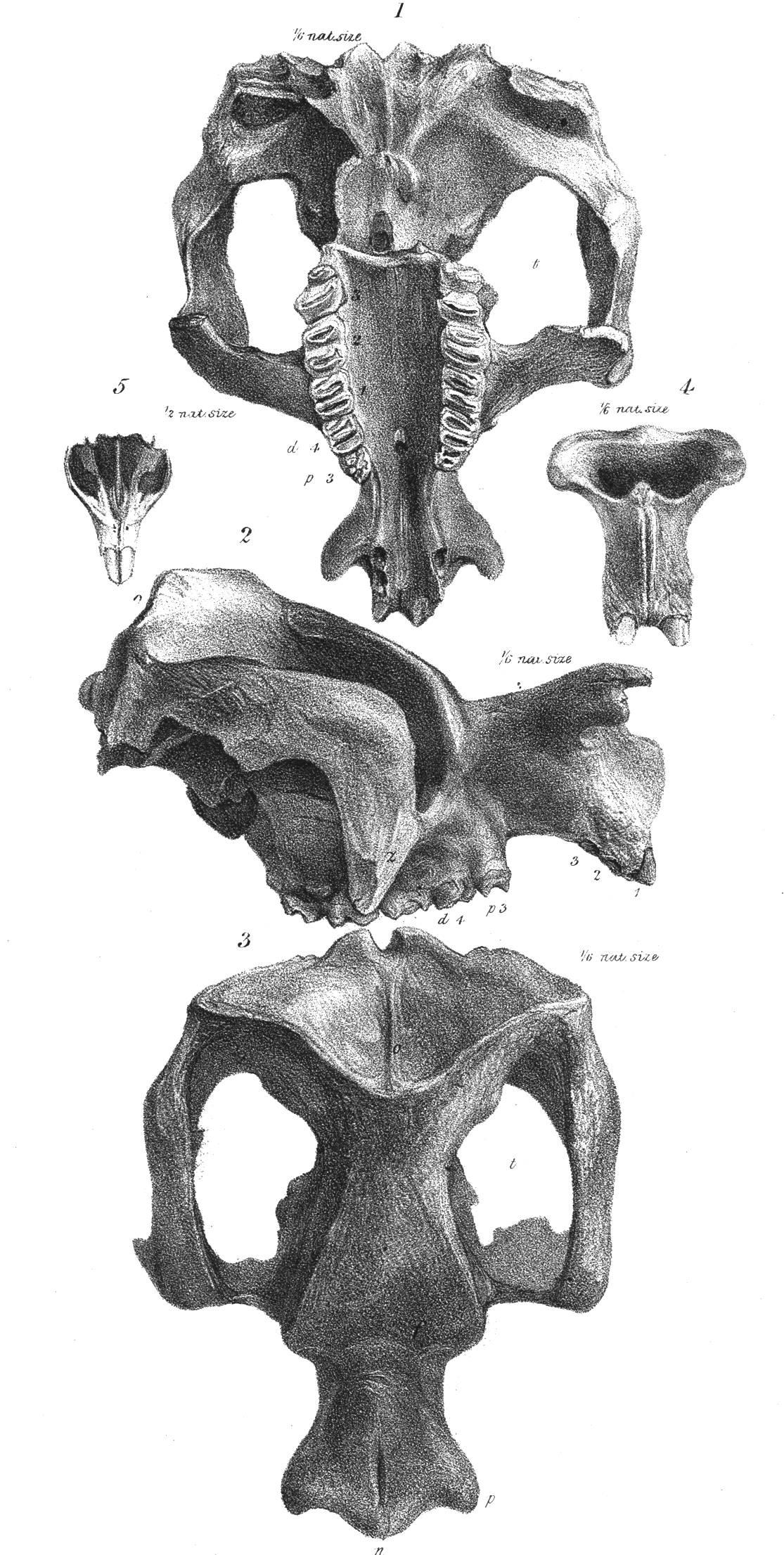Zygomaturus BW on:
[Wikipedia]
[Google]
[Amazon]
''Zygomaturus'' is an extinct genus of giant 
 It was a large animal, weighing 500 kg (1100 lbs) or over 700 kg (1544 lbs) and standing about 1.5 m (4.9 ft) tall and 2.5 m (8.2 ft) long.
It was a large animal, weighing 500 kg (1100 lbs) or over 700 kg (1544 lbs) and standing about 1.5 m (4.9 ft) tall and 2.5 m (8.2 ft) long.
The Diprotodontids3D rotatable model of the skull of ''Zygomaturus trilobus''
{{Taxonbar, from=Q134365 Prehistoric vombatiforms Pleistocene marsupials Pleistocene genus extinctions Pleistocene mammals of Australia Fossil taxa described in 1857 Prehistoric marsupial genera
marsupial
Marsupials are any members of the mammalian infraclass Marsupialia. All extant marsupials are endemic to Australasia, Wallacea and the Americas. A distinctive characteristic common to most of these species is that the young are carried in a ...
belonging to the family Diprotodontidae
The Diprotodontidae are an extinct family of large herbivorous marsupials, endemic to Australia and New Guinea during the Oligocene through Pleistocene periods from 28.4 million to 40,000 years ago. The family consisted of large quadrupedal te ...
which inhabited Australia from the Late Miocene
The Miocene ( ) is the first epoch (geology), geological epoch of the Neogene Period and extends from about (Ma). The Miocene was named by Scottish geologist Charles Lyell; the name comes from the Greek words (', "less") and (', "new") and mea ...
to Late Pleistocene.

Description
 It was a large animal, weighing 500 kg (1100 lbs) or over 700 kg (1544 lbs) and standing about 1.5 m (4.9 ft) tall and 2.5 m (8.2 ft) long.
It was a large animal, weighing 500 kg (1100 lbs) or over 700 kg (1544 lbs) and standing about 1.5 m (4.9 ft) tall and 2.5 m (8.2 ft) long.
Palaeobiology
In an analysis of remains fromCuddie Springs
Cuddie Springs is a notable archaeological and paleontological site in the semi-arid zone of central northern New South Wales, Australia, near Carinda in Walgett Shire. Cuddie Springs is an open site, with the fossil deposits preserved in a cl ...
, the carbon isotope ratios suggests that it consumed both C3 and C4 plants, with a dental microwear Dental microwear analysis is a method to infer diet and behavior in extinct animals, especially in fossil specimens. Typically, the patterns of pits and scratches on the occlusal or buccal surface of the enamel are compared with patterns observed ...
texture indicative of browsing
Browsing is a kind of orienting strategy. It is supposed to identify something of relevance for the browsing organism. When used about human beings it is a metaphor taken from the animal kingdom. It is used, for example, about people browsing o ...
. Preserved remains suggest that ''Zygomaturus'' was widely distributed over Australia during the Pleistocene
The Pleistocene ( , often referred to as the ''Ice age'') is the geological epoch that lasted from about 2,580,000 to 11,700 years ago, spanning the Earth's most recent period of repeated glaciations. Before a change was finally confirmed in ...
.
Evolution and extinction
The earliest members of the genus such as ''Zygomaturus gilli'' appeared during the LateMiocene
The Miocene ( ) is the first epoch (geology), geological epoch of the Neogene Period and extends from about (Ma). The Miocene was named by Scottish geologist Charles Lyell; the name comes from the Greek words (', "less") and (', "new") and mea ...
, during the regional Waitean faunal stage. It is thought that the youngest species, ''Zygomaturus trilobus'' became extinct curing the latter half of the Late Pleistocene, with typical estimates being about 45,000 years ago, around the time of Aboriginal arrival in Australia. A surprisingly late date between 33.3 ±3.7 Kya and 36.7 ±5.1 Kya was reported in 2017 from the Willandra Lakes Region
The Willandra Lakes Region is a World Heritage Site in the Far West region of New South Wales, Australia. The Willandra Lakes Region is the traditional meeting place of the Muthi Muthi, Ngiyampaa and Barkinji Aboriginal tribes. The area was ins ...
in New South Wales, which if correct would represent the latest known date for any Australian Megafauna.
Related genera
References
Further reading
*'' Wildlife of Gondwana: Dinosaurs and Other Vertebrates from the Ancient Supercontinent (Life of the Past)'' by Pat Vickers Rich, Thomas Hewitt Rich, Francesco Coffa, and Steven Morton *''Marsupial Nutrition'' by Ian D. Hume * *''Life of Marsupials'' by Hugh Tyndale-Biscoe *'' Magnificent Mihirungs: The Colossal Flightless Birds of the Australian Dreamtime (Life of the Past)'' by Peter F. Murray, Patricia Vickers-Rich, and Pat Vickers Rich *'' Classification of Mammals'' by Malcolm C. McKenna and Susan K. Bell *'' Australia's Lost World: Prehistoric Animals of Riversleigh'' by Michael Archer, Suzanne J. Hand, and Henk Godthelp * ''World Encyclopedia of Dinosaurs & Prehistoric Creatures: The Ultimate Visual Reference To 1000 Dinosaurs And Prehistoric Creatures Of Land, Air And Sea ... And Cretaceous Eras (World Encyclopedia)'' by Dougal Dixon * ''The Illustrated Encyclopedia Of Prehistoric Life'' by Dougal DixonExternal links
The Diprotodontids
{{Taxonbar, from=Q134365 Prehistoric vombatiforms Pleistocene marsupials Pleistocene genus extinctions Pleistocene mammals of Australia Fossil taxa described in 1857 Prehistoric marsupial genera